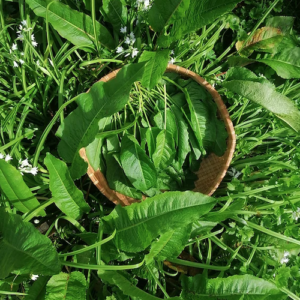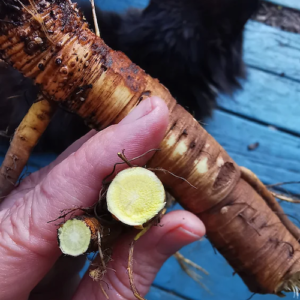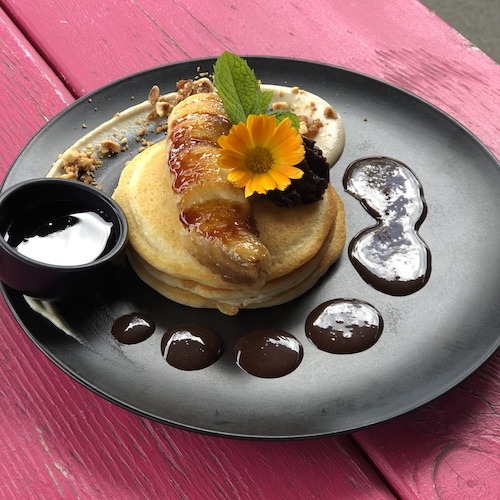How incredible that the roots of just one herb that is often dismissed as a nuisance weed can support our body in so many different ways!
It’s amazing just how much nutritional and medicinal value we can access for free from weeds that grow all around us. Anna Valentine from The Veggie Tree is incredibly knowledgable on this topic and has a wealth of information to share, including how to turn yellow dock root into a tonic that is highly beneficial for multiple areas of health.
Scroll down to find out about the medicinal qualities of yellow dock root, the recipe for making them into a tonic, and information about Anna’s latest cook book, Abundance.
From Anna …
Whats up Dock?!
Dock has a bit of a bad rap here in New Zealand, but it actually is a fabulous support herb for the human body and what better way to get rid of it in places you don’t want it than to make medicine from its roots!
This is a recipe I use for an Iron, Blood, Liver and Digestive Support Tonic. The yellow colouring in the root of yellow dock shows the medicinal qualities of this fabulous root, perfect for harvesting right now in the winter while the energy is concentrated there.
From the buckwheat family Polygonaceae, Rumex crispus – Yellow dock and Rumex obtusifolius – Broad leaf dock are the most common here in New Zealand. Both docks are edible from roots to the seeds but the yellow dock is what you want to use for this tonic with its yellow root colouring showing its medicinal properties.
Yellow dock has a thiner curly edged leaf. The most tender leaves and the best lemony (sour) flavoured ones come from young dock plants before the flower stalks develop. The leaves are bitter, astringent and contain oxalates so don’t want to be eating in cup fulls, as with all wild greens they have concentrated vitamins and minerals so you get more nutrients from them than commercially grown produce so don’t need to eat so much to gain their benefits and naturally contain vitamin C than oranges and more vitamin A than carrots.
They also contain vitamins B1 and B2, and iron, potassium and magnesium. I add them to salad mixes, to wilted greens or soup. The seeds can be ground into flour and added to breads and batters. Dock root draws up nutrients from deep in the earth so is great for the garden as it breaks up earth and stagnation in the soil.
Dock has the highest non heme iron out of any plant based source, it concentrates iron from the earth and combines it with the vitamins and minerals needed to absorb this valuable mineral making it ideal for helping as a blood builder and is often used for anemia. Yellow docks cooling properties ease inflammation to the digestive tract as it helps strengthen and tone the gut. Its bitter properties activate the liver and gall bladder, aiding in the digestion of fats and absorption of nutrients. It is used as a blood tonic and cleanser along with a lymphatic stimulant that improves the metabolic functioning of the body to encourage the breakdown and elimination of toxins and waste.
The root is bitter, astringent and high in minerals and are usually consumed as tea or tonic. Dock leaf and the sap from the base of the leaf is used for chronic skin conditions like acne and eczema, which often have an underlying cause in liver congestion. It can be used as a poultice or internally for this, you could also use for itchy chicken pox.
Iron, Blood, Liver and Digestive Support Tonic
The vodka (or any spirit you prefer) or apple cider vinegar draws out the medicinal properties and the honey makes it taste a bit nicer along with its own incredible health benefits as does pure maple syrup. I add rose hips for their vitamin C content which helps our bodies absorb iron and they also contain many important antioxidants that are naturally anti-inflammatory, shield immune cells from environmental damage and encourage the production of white blood cells, but you can leave them out if you wish.
Ingredients
Yellow dock root
Rose hips
Vodka or apple cider vinegar
Honey or pure maple syrup
Method
To make this tonic dig up a dock root or two with a garden fork, give it a clean and slice thinly. Add to a clean sterilised jar along with crushed rose hips, a couple of spoons of honey then fill the jar with vodka or apple cider vinegar, cap, shake, label and leave for 2 weeks to 2 months, shaking every now and then. Strain through muslin to catch the little hairs from the rose hips and take 2 ml twice a day.
You can collect rose hips when foraging or buy them dried here.
Have you got yourself a copy of Anna’s latest cook book yet?
From Anna about Abundance …
Abundance is the culmination of the best of the best of my seasonal recipes enhanced with everyday plant-based essentials made from scratch with whole foods. Inspired by the plant kingdoms abundance, the recipes you will find in this book are what I feed my family every day. I strive to make plant-based food accessible, easy, healthy and delicious, recipes that you will come back to time and time again.
This is a compendium of plant-based recipes, the everyday basics that are my fridge and pantry staples which I literally make every week. If you are vegetarian, vegan, plant predominant or just super keen to eat more plants, you have come to the right place. I have even gone so far as making plant protein meat alternatives out of natural ingredients without any unnecessary additives and preservatives, that are super tasty and hit the spot for smoky cravings, and are there for you if you just want to give the kids burgers or nuggets and chips for dinner. The options for making plant milk, cheese, butter, cream amongst many others from scratch are there if you want it, also every recipe can be made fully plant-based and gluten-free.
Find out more about Abundance including how to order here.







About The Author: Katie Brooks
More posts by Katie Brooks